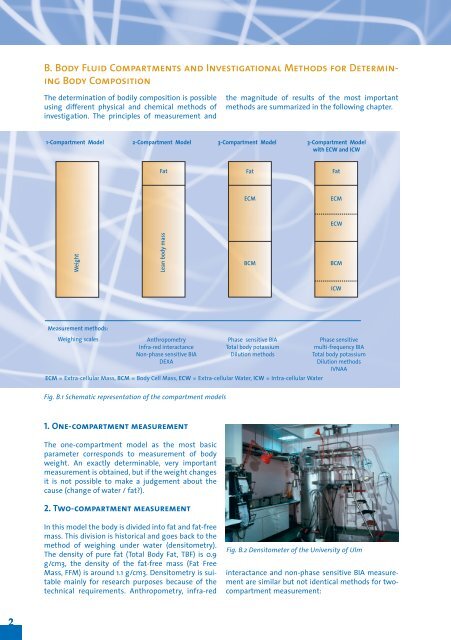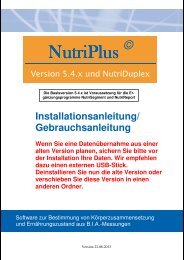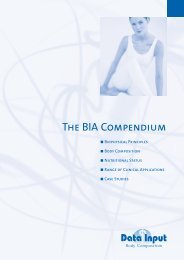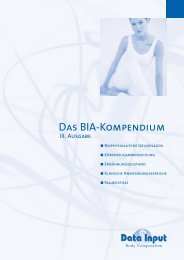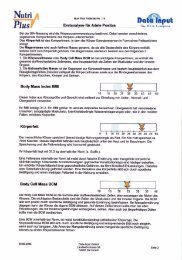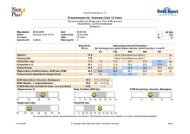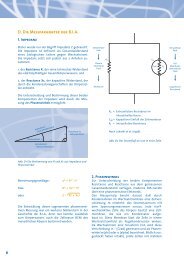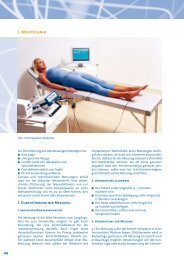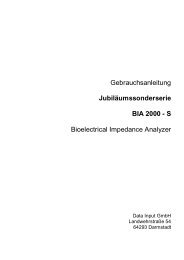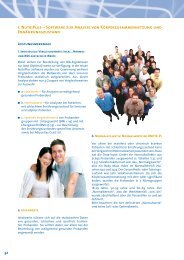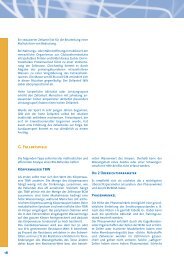2 B. Body Fluid Compartments and Investigational ... - Data-input.de
2 B. Body Fluid Compartments and Investigational ... - Data-input.de
2 B. Body Fluid Compartments and Investigational ... - Data-input.de
You also want an ePaper? Increase the reach of your titles
YUMPU automatically turns print PDFs into web optimized ePapers that Google loves.
2<br />
B. <strong>Body</strong> <strong>Fluid</strong> <strong>Compartments</strong> <strong>and</strong> <strong>Investigational</strong> Methods for Determining<br />
<strong>Body</strong> Composition<br />
The <strong>de</strong>termination of bodily composition is possible<br />
using different physical <strong>and</strong> chemical methods of<br />
investigation. The principles of measurement <strong>and</strong><br />
1-Compartment Mo<strong>de</strong>l 2-Compartment Mo<strong>de</strong>l 3-Compartment Mo<strong>de</strong>l 3-Compartment Mo<strong>de</strong>l<br />
with ECW <strong>and</strong> ICW<br />
Weight<br />
Measurement methods:<br />
1. One-compartment measurement<br />
The one-compartment mo<strong>de</strong>l as the most basic<br />
parameter corresponds to measurement of body<br />
weight. An exactly <strong>de</strong>terminable, very important<br />
measurement is obtained, but if the weight changes<br />
it is not possible to make a judgement about the<br />
cause (change of water / fat?).<br />
2. Two-compartment measurement<br />
In this mo<strong>de</strong>l the body is divi<strong>de</strong>d into fat <strong>and</strong> fat-free<br />
mass. This division is historical <strong>and</strong> goes back to the<br />
method of weighing un<strong>de</strong>r water (<strong>de</strong>nsitometry).<br />
The <strong>de</strong>nsity of pure fat (Total <strong>Body</strong> Fat, TBF) is 0.9<br />
g/cm3, the <strong>de</strong>nsity of the fat-free mass (Fat Free<br />
Mass, FFM) is around 1.1 g/cm3. Densitometry is suitable<br />
mainly for research purposes because of the<br />
technical requirements. Anthropometry, infra-red<br />
Fat Fat<br />
Fat<br />
Lean body mass<br />
Weighing scales Anthropometry<br />
Infra-red interactance<br />
Non-phase sensitive BIA<br />
DEXA<br />
Fig. B.1 Schematic representation of the compartment mo<strong>de</strong>ls<br />
the magnitu<strong>de</strong> of results of the most important<br />
methods are summarized in the following chapter.<br />
ECM ECM<br />
ECW<br />
BCM BCM<br />
Phase sensitive BIA<br />
Total body potassium<br />
Dilution methods<br />
ECM = Extra-cellular Mass, BCM = <strong>Body</strong> Cell Mass, ECW = Extra-cellular Water, ICW = Intra-cellular Water<br />
ICW<br />
Phase sensitive<br />
multi-frequency BIA<br />
Total body potassium<br />
Dilution methods<br />
IVNAA<br />
Fig. B.2 Densitometer of the University of Ulm<br />
interactance <strong>and</strong> non-phase sensitive BIA measurement<br />
are similar but not i<strong>de</strong>ntical methods for twocompartment<br />
measurement:
a. Anthropometry<br />
The thickness of skin folds of<br />
<strong>de</strong>fined parts of the body is measured<br />
with the help of a callipers<br />
(mostly on the biceps <strong>and</strong> triceps, as<br />
well as sub-scapular <strong>and</strong> supra-iliac). Conclusions<br />
can be ma<strong>de</strong> about body fat from the thickness of<br />
the skin folds.<br />
b. Infra-red interactance<br />
This method uses harmless infra-red light in or<strong>de</strong>r to<br />
measure the percentage of total body fat on the<br />
biceps of the dominant arm with the help of a near<br />
infra-red probe.<br />
Fig. B.3 Infra-red interactance measurement (Futrex)<br />
c. Non-phase sensitive BIA measurement<br />
This method measures the total resistance of the<br />
body (impedance Z). By calculating body water, the<br />
compartments for body fat <strong>and</strong> lean body mass can<br />
be obtained. This does not give a <strong>de</strong>termination of<br />
the phase angle <strong>and</strong>, as such, a subdivision of impedance<br />
into water <strong>and</strong> cellular resistance, so that no<br />
judgement can be ma<strong>de</strong> about the body cell mass<br />
BCM or the extra-cellular mass ECM with the nonphase<br />
sensitive BIA.<br />
The compartments measured using the last three<br />
methods are known as body fat (BF) <strong>and</strong> as lean body<br />
mass (LBM), in comparison to the fat-free mass (FFM)<br />
which is obtained in the case of <strong>de</strong>nsitometry. The<br />
difference is that <strong>de</strong>nsitometry measures pure<br />
triglyceri<strong>de</strong>s, whereas body fat also contains 15-18%<br />
water <strong>and</strong> approx. 2% protein.<br />
3. Three-compartment measurement<br />
The 3-compartment mo<strong>de</strong>l arises by subdividing the<br />
lean body mass into the body cell mass BCM <strong>and</strong> the<br />
extra-cellular mass ECM.<br />
The BCM is the sum of all aerobic oxidizing, metabolically<br />
active cells, in other words the muscles,<br />
internal organs <strong>and</strong> the CNS. The interstitial <strong>and</strong><br />
trans-cellular spaces are part of the extra-cellular<br />
mass ECM, as well as the skeleton <strong>and</strong> connective tissue.<br />
Large displacements between the BCM <strong>and</strong> ECM<br />
can arise without changes to the bodyweight <strong>and</strong><br />
lean body mass. Measurements in the 3-compartment<br />
mo<strong>de</strong>l are possible with the following simple<br />
methods:<br />
a. Phase sensitive BIA measurement<br />
The phase sensitive technique of measuring allows<br />
the impedance Z to be differentiated into its two<br />
components resistance R (water resistance) <strong>and</strong><br />
reactance Xc (cell resistance), so that a differentiation<br />
can be ma<strong>de</strong> between body cell mass <strong>and</strong> extracellular<br />
mass.<br />
Fig. B.4 Phase sensitive mono-frequency <strong>de</strong>vice<br />
COMPARTMENTS<br />
3
4<br />
b. Phase sensitive multi-frequency measurement<br />
A further step towards making a more exact diagnosis<br />
of body composition <strong>and</strong> nutritional status can be<br />
achieved using phase sensitive multi-frequency<br />
analysis. By using an additional <strong>de</strong>termination of<br />
resistance at low frequency (1 or 5 kHz), it is possible<br />
to achieve a subdivision of the total body water TBW<br />
into intra-cellular <strong>and</strong> extra-cellular water.<br />
Deviations in mass of BCM <strong>and</strong> ECM can thus be estimated<br />
differentially with regard to anabolic/catabolic<br />
processes or shifts in water. Phase sensitive multifrequency<br />
analysis is indicated in particular in<br />
patients with disturbances in water balance, e.g. in<br />
heart <strong>and</strong> kidney failure, oe<strong>de</strong>ma, patients un<strong>de</strong>rgoing<br />
treatment with parenteral nutritional therapy<br />
<strong>and</strong> intensive care patients.<br />
Fig. B.5 Phase sensitive multi-frequency <strong>de</strong>vice<br />
4. Other investigational methods for<br />
<strong>de</strong>termining body composition<br />
a. Total body potassium<br />
Fat is potassium-free <strong>and</strong> bones contain only traces of<br />
potassium. For this reason, practically the entire content<br />
of potassium in the body (98%) is to be found in<br />
the cells of the BCM. The natural radioactive isotope<br />
K40 is present wherever potassium is found at a level<br />
of 0.012%. By measuring the isotope K40 it is possible<br />
to draw conclusions about total body potassium <strong>and</strong><br />
thus the BCM. The measurement of K40 is done in a<br />
whole body counting chamber.<br />
b. DEXA (Dual Energy X-ray Absorptiometry)<br />
DEXA is carried out using a special x-ray apparatus at<br />
a very low radiation dosage. Two beams of photon<br />
Fig. B.7 DEXA apparatus (Hologic Inc., USA)<br />
radiation with different energy levels are used,<br />
which gives the method its name. DEXA can be used<br />
to differentiate between bone mass, fat mass <strong>and</strong><br />
fat-free mass.<br />
c. Dilution methods<br />
The dilution techniques are used mostly to <strong>de</strong>termine<br />
total body water TBW. Deuterated water is<br />
used as a non-radioactive tracer; it can be given orally<br />
or parenterally. About 2 hours after the dose, the<br />
concentration of the tracer is <strong>de</strong>termined in the<br />
urine <strong>and</strong> blood using gas chromatography or mass<br />
spectrometry, allowing a conclusion to be drawn<br />
about the total body water. The extra-cellular fluid<br />
can be <strong>de</strong>termined selectively using bromi<strong>de</strong> or sulphate.<br />
d. IVNAA (In-vivo Neutron Activation Analysis) This is<br />
probably the most expensive of all methods for<br />
<strong>de</strong>termining the body composition; but it also provi<strong>de</strong>s<br />
the most differentiated assessment. A beam of<br />
neutrons aimed at the body induces the emission of<br />
gamma radiation with a characteristic spectrum. In<br />
this way, single elements can be <strong>de</strong>termined, such as<br />
total body potassium or calcium. The corresponding<br />
compartment can be calculated from the proportion<br />
of these elements.<br />
Further imaging processes for <strong>de</strong>termining the composition<br />
of the body are mentioned below:<br />
Nuclear magnetic resonance technique (NMR)<br />
Computer tomography (CT)<br />
Magnet resonance tomography (MRT)<br />
Photon absorption measurement<br />
Fig. B.6 Potassium chamber of the University of Texas


